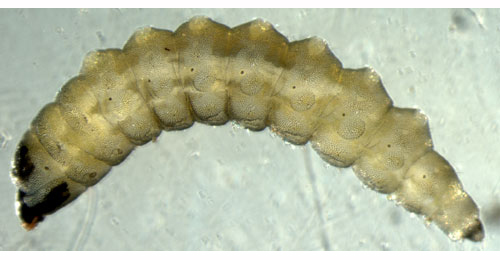|
||||||
|
Orchestes
pilosus (Fabricius, 1781) Curculio
pilosus
Fabricius, 1781 |
|||||||||||||||||||||||||||||||||||||||||||||||||||
Leaf-miner: Oviposition in the underside of a vein, usually the midrib. Here an oviposition scar remains. From this point a small full depth blotch develops, of about one cm in diameter, at the leaf margin, mostly in the leaf tip. The initial part of the mine, a quickly broadening corridor, later often tears. Frass blackish-green, in short thread fragments, pasted to the upper epidermis. Pupation in the mine, in a globular cocoon, made from secretion that is produced by the larva itself (Bladmineerders van Europa). The mine is at the leaf margin and usually between two lobes (British leafminers). Larva: The larvae of beetles have a head capsule and chewing mouthparts with opposable mandibles and lack abdominal legs (see examples). The larva is illustrated in British leafminers and Bladmineerders van Europa.
Pupa: The pupae of beetles have visible head appendages, wings and legs which lie in sheaths (see examples). Inside or outside the leaf (British leafminers). Hosts in Great Britain and Ireland:
Hosts elsewhere:
Time of year - larvae: April - June (British leafminers). Time of year - adults: Currently unknown. Distribution in Great Britain and Ireland: Widespread in Britain including Bedfordshire, Berkshire, Breconshire, Buckinghamshire, Cardiganshire, Carmarthenshire, Cheshire, Cumberland, Denbighshire, Derbyshire, Dorset, East Gloucestershire, East Kent, East Norfolk, East Ross, East Suffolk, Glamorgan, Herefordshire, Huntingdonshire, Leicestershire, Monmouthshire, Montgomeryshire, North Essex, North Wiltshire, North-east Yorkshire, Northamptonshire, Nottinghamshire, Oxfordshire, Radnorshire, Shropshire, South Hampshire, South Wiltshire, Stafford, Surrey, Warwickshire, West Gloucestershire, West Kent, West Norfolk, West Suffolk, West Sussex and Worcestershire (NBN Atlas) Also recorded in the Republic of Ireland and Northern Ireland (Fauna Europaea) and in Ireland (InvertebrateIreland Online). Distribution elsewhere: Widespread in continental Europe including Bulgaria, Corsica, French mainland, Germany, Italian mainland, Moldova, Norwegian mainland, Poland, Romania, Russia - Central and South, Sardinia, Sicily, Slovakia, Sweden, Ukraine and Yugoslavia. Also recorded in the Near East (Fauna Europaea). NBN Atlas links to known host species:
British and Irish Parasitoids in Britain and elsewhere: Currently unknown. |
|||||||||||||||||||||||||||||||||||||||||||||||||||
|
|
|
| External links: | Search the internet: |
|
Biodiversity
Heritage Library |
Find
using Google Find using Google Scholar Find images using Google |
| Last updated 08-Jul-2019 Brian Pitkin | ||

